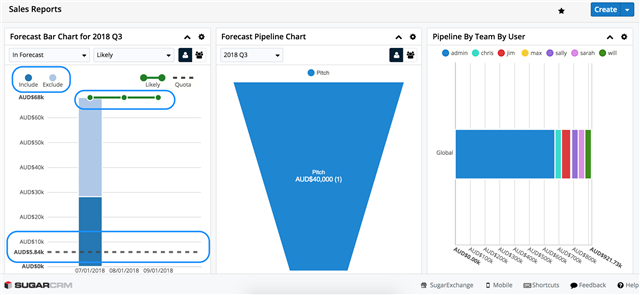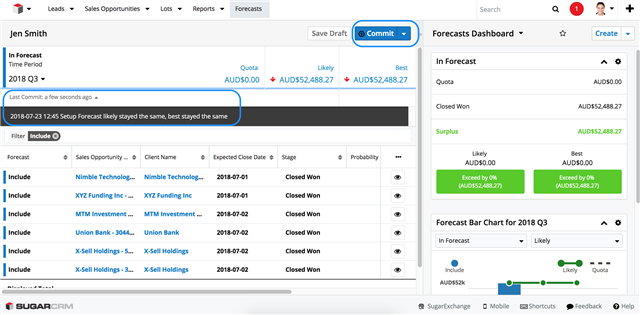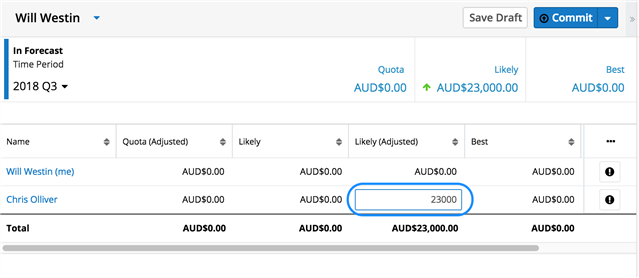Gaining accurate forecasting can be a real challenge when your deal information isn't managed and updated in the right way.
Without a means of proactively managing, reviewing and adjusting your forecast, it's hard to gain a clear picture of where your new business pipeline is at.
SugarCRM's Forecasting module provides a robust solution to this problem and takes a logical, thoughtful approach to improve forecast accuracy for businesses. This article covers all the key aspects of how best to manage forecasting for accuracy.
1. Set-Up a Reporting Structure
Setting up your 'report to' structure will allow your management team to visually see pipeline performance at a glance across the sales team. This includes their current quota targets, likely revenue for the period, as well as the 'adjusted revenue' figure management can enter in to more accurately reflect potential revenue for the period:

Setting up a report-to structure is as easy as going into the User profile of each of your staff, and inputting who they report to in the "Reports to" look up setting. Once set-up, the manager will see everyone in they manage in their forecasts module.
Understanding forecasting terminology
Quota: This is the revenue goal you set for each salesperson to achieve for a specific period. SugarCRM Forecasting provides two forecasting options:
- "Yearly" if your sales organisation has quarterly quotas which build up to a yearly goal.
- "Quarterly" if you operate with monthly goals building to quarterly goals instead.
What revenue metrics do we want to understand?
Forecasting is only useful if we can accurately understand the likelihood of actually winning new business. Below are the key areas SugarCRM allows you to differentiate your forecast values:
- Likely: The likely value of revenue for the period.
- Best: The best-case scenario of revenue for the period.
- Worst: The worst-case scenario of revenue for the period.
- Likely Adjusted: This is the adjusted figure you as a manager have input to more accurately reflect what you 'feel' the sales person will actually bring in for the period.
Ps - Sales staff can't see the likely adjusted figure.
Deal information is only as accurate as the frequency in which it get's updated
2. Set-Up Target Revenue Quotas
By giving a visual target to each of your sales reps, both they and you have a marker-point to review their performance.
In the Forecast Bar Chart dashlet above (the one in the far left), you will notice the following key markers which help you both understand your revenue:

Likely Revenue Line: Which indicates the total revenue likely to be brought in.
Quota Line: If you are a salesperson, this line will denote your assigned quota
Include and Exclude Values: You can either 'include' a deal in your forecast when you feel it is likely to proceed, or, you could mark a deal as 'excluded' to show management you are unsure of this deal and would not count on it being a solid revenue generator in this period.
Tip: If your Exclude Bar is a lot larger, you may want to consider reviewing the qualification process with your sales reps, as this is an indicator that a larger proportion of Deals fall into the 'I'm unsure category.'
3. Set and Discuss Data Entry Expectations with your Sales Team
This is arguably the most important aspect of accurately managing your forecasts. Deal information is only as accurate as the frequency in which it gets updated. Decide how often you need to review business development performance and set expectations clearly with your sales team around how deal information needs to be prepped for each review.

Be Consistent.
Some suggestions of expectations to set are:
- Review which deals you'd like to include and exclude in your forecast and update your deal notes often so your manager can understand your thought patterns behind deals included and excluded.
- Review the 'Expected Close Date' across all your deals prior to committing your forecast to your manager. Your expected close date is the date understood to be the commencement of the contract.
- Make sure you formally "Commit" your forecast prior to a specific interval. This could be a weekly commit of numbers, or perhaps even a monthly depending on how often you want to review performance. This ensures that changes in forecasting metrics can easily be tracked as below:
4. Periodically Review Committed Forecasts and Deal Information
If you've been in sales for some time, you'll know that most forecasts tend to be more on the 'positive' side i.e. Higher than reality.
In order to gain accurate forecasting information, reviewing committed forecasts allows you to set the adjusted likely value of new business against each of your sales reps, and understand from your experience where new revenue is more realistically at.
Setting a reviewed deal value

Deal Drill Down
Reviewing actual deal information is also useful in order to understand the finer details about deals at a more granular level. The below screen shot shows the individual deals managed by a sales rep, and how each can be previewed and further drilled into to understand key deal information:

5. Identify Potential Deal Risks
When you're not managing deals directly and have to rely on the information and diligence of your sales team, it can be quite challenging to identify risks clearly.
Fortunately, there are a few ways to achieve better clarity in a simple, straight forward way:
- Get Notified: Set-Up Triggered Alerts for Deals that stay open for too long, or stay in a specific sales stage too long. This can be achieved in SugarCRM Enterprise with simple triggered emails in SugarCRM's advanced workflow engine. This is a quick and easy way to ensure you stay on-top of any high value deals that seem to be stagnant.
- Ensure Proper Relationship Coverage: For all deals, drilling into the deal the sales rep should have the correct contacts by role fully mapped out against the opportunity. If there isn't at least one identified decision maker on the opportunity, the deal is at risk of not being with the correct power base.
- Check for Planned Next Steps: Are there any scheduled tasks, planned or held phone calls, or notes attached to the opportunity that tell us there is movement in this deal? Without a clear plan of scheduled activities, it is difficult to know how and when next steps need to take place. If there are no activities, this could be an identifier that there is no understanding of what needs to happen next.
As we can see, there are a lot of simple but effective ways of improving the way we can manage our information and drive insights. Forecasting is not only important for management, but for sales staff to fully understand their pipeline and ensure they cover the necessary activities to ensure they progress meaningful relationships.
If you find value in this article, please like, comment, or share it!
